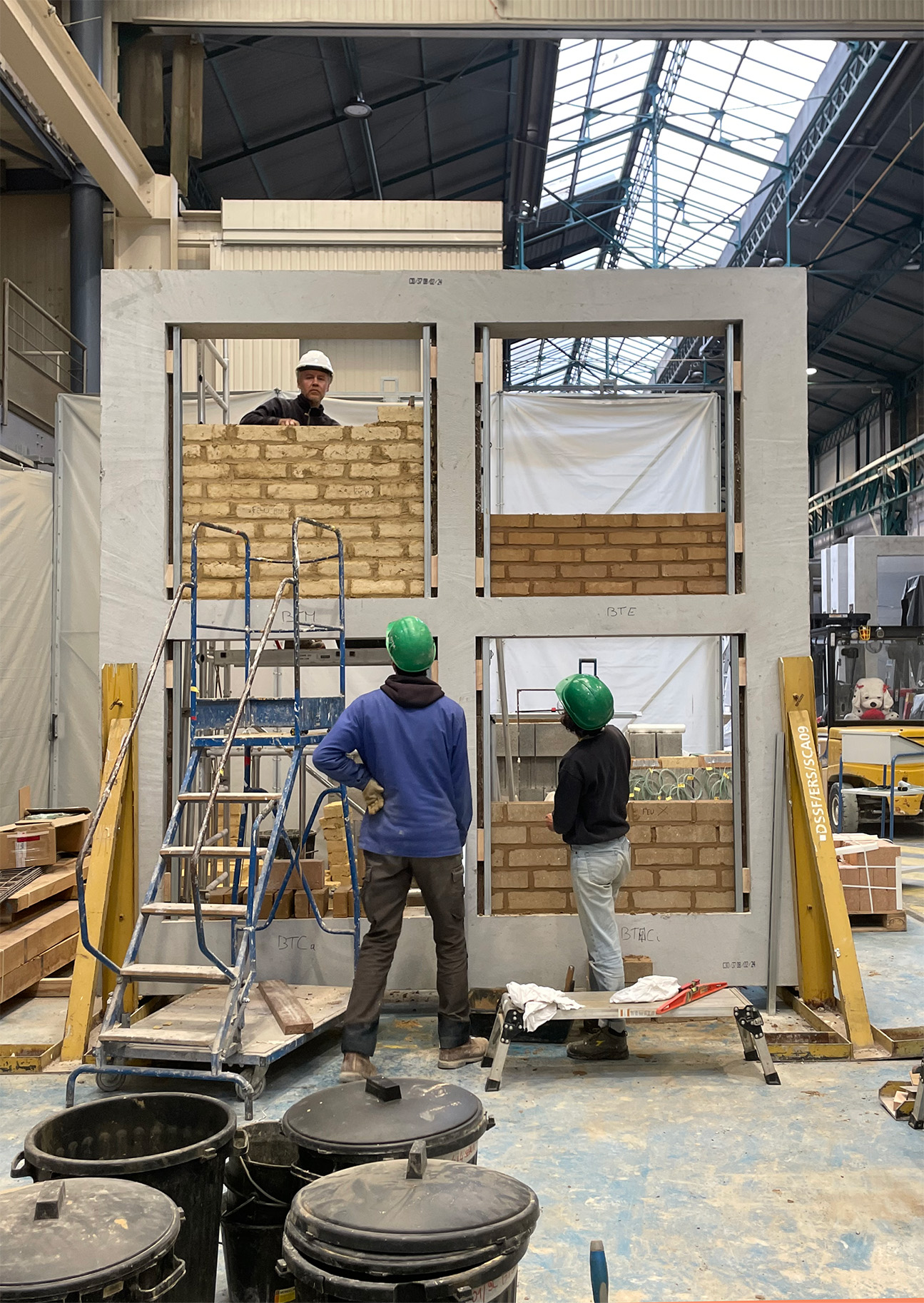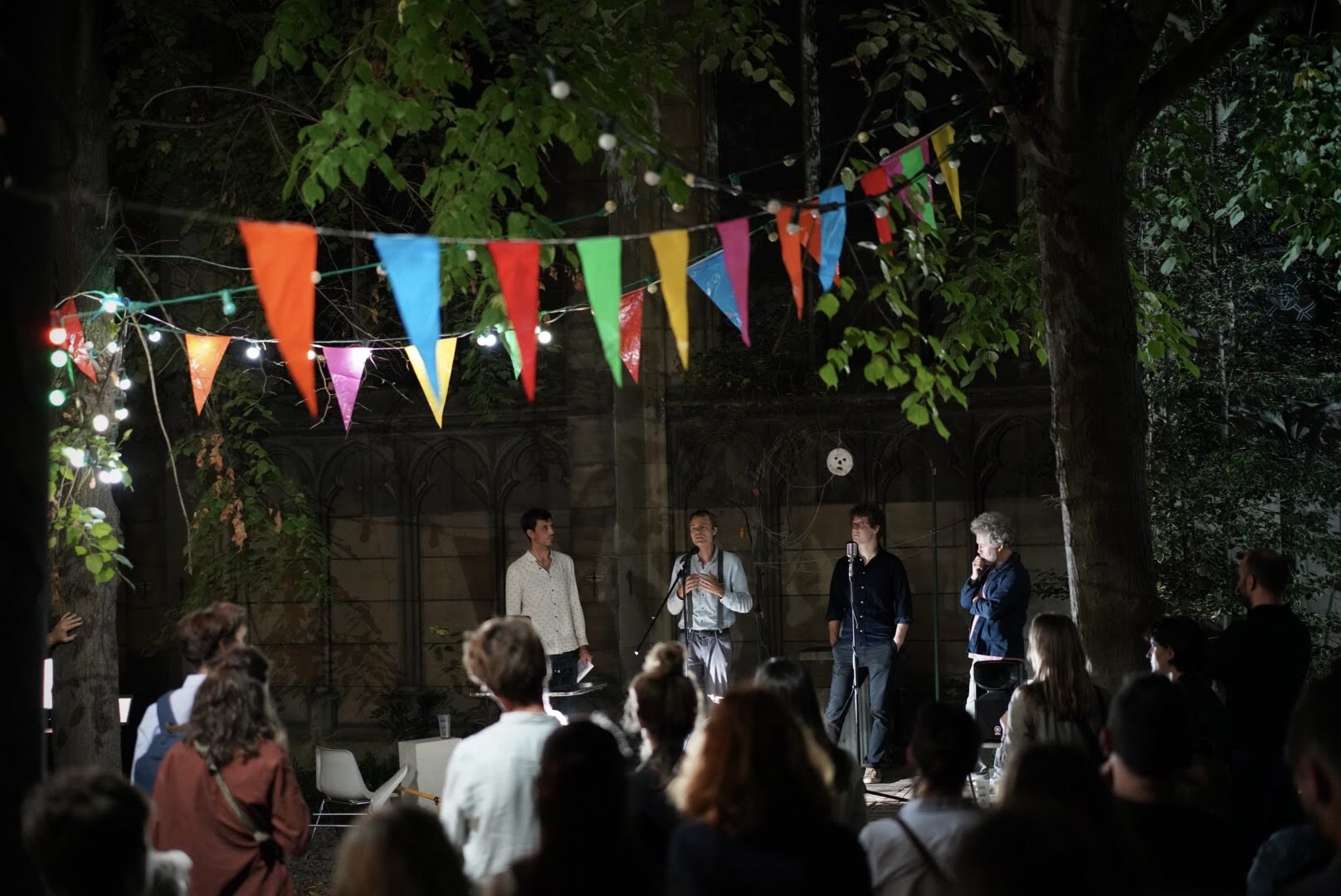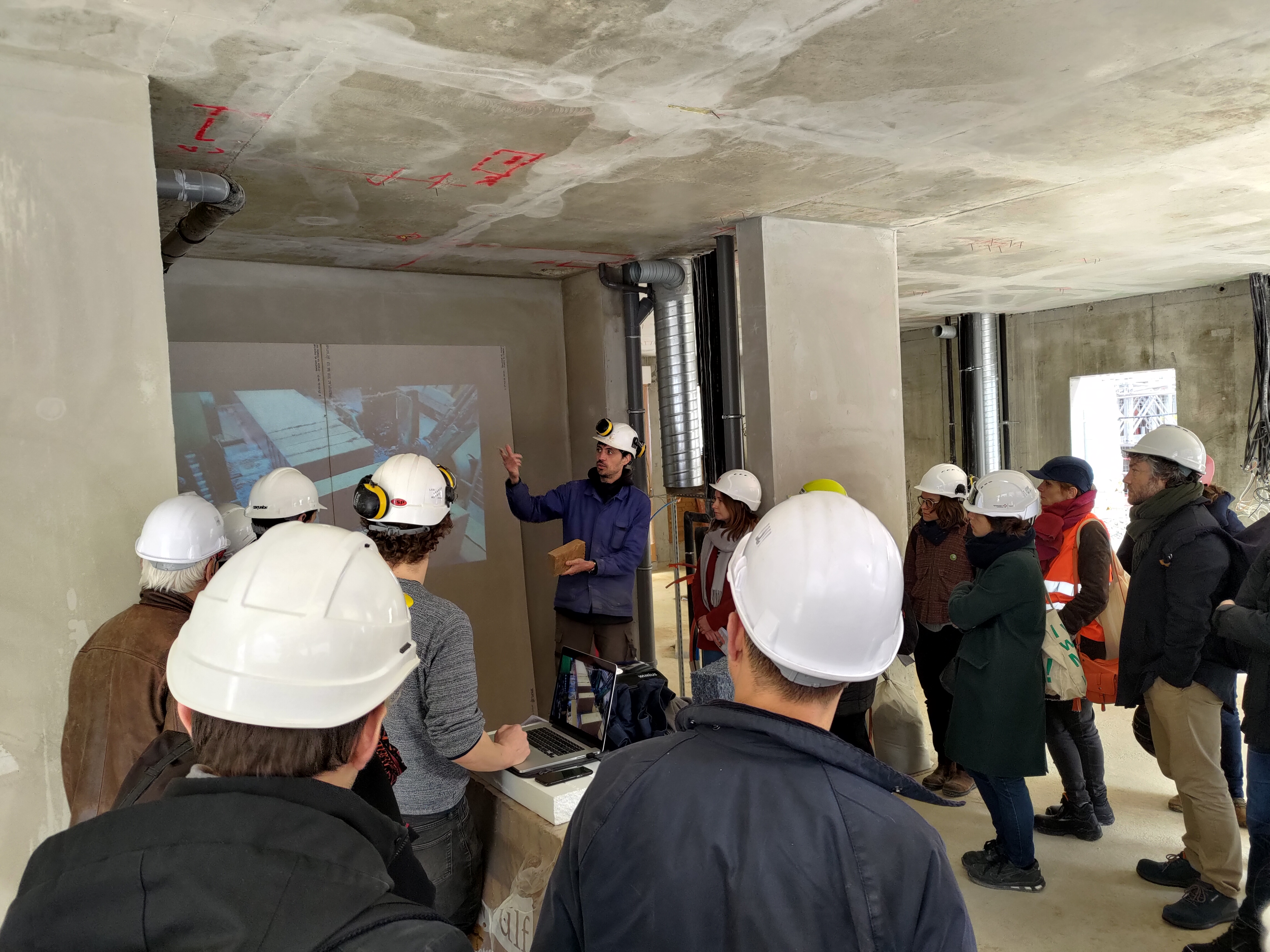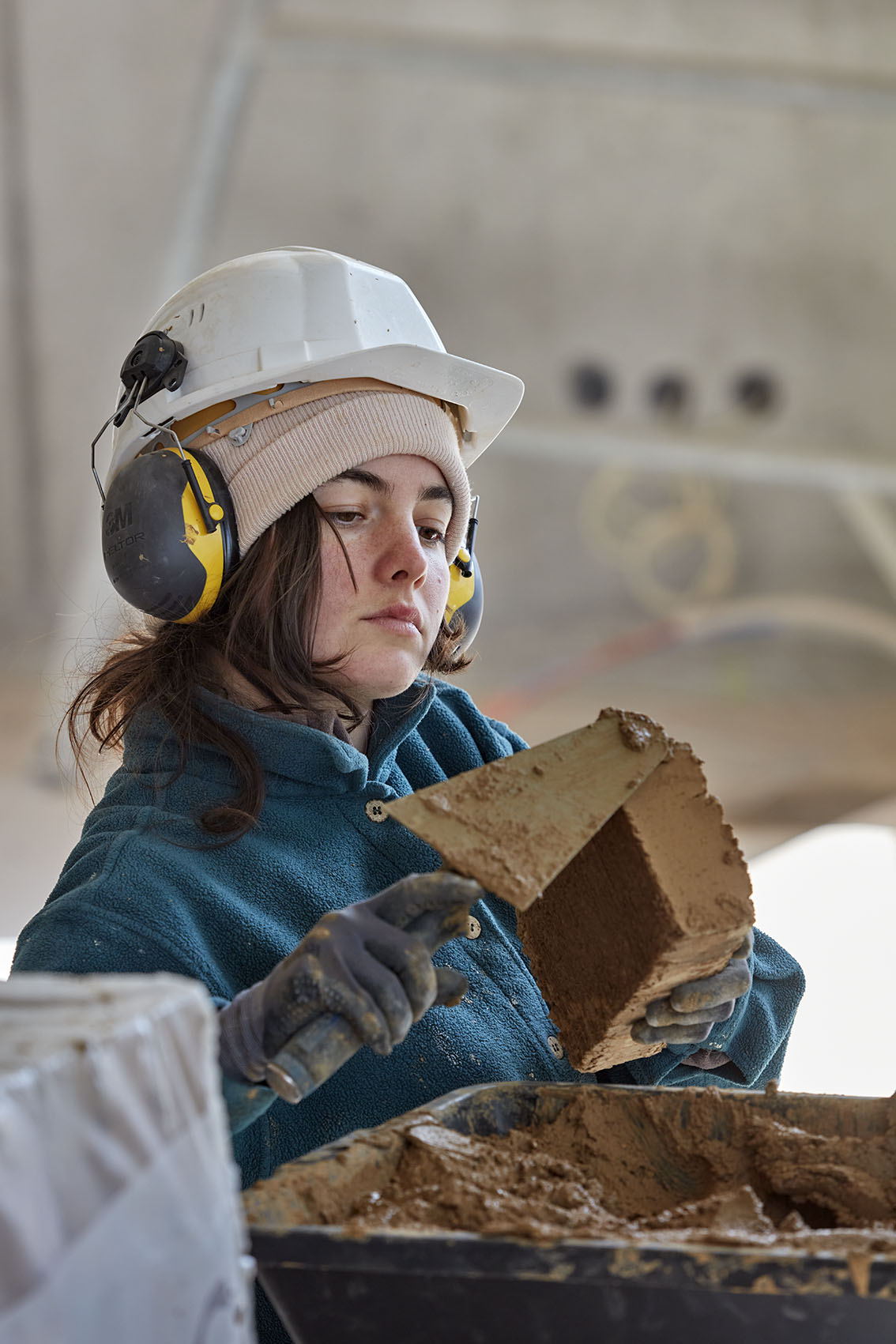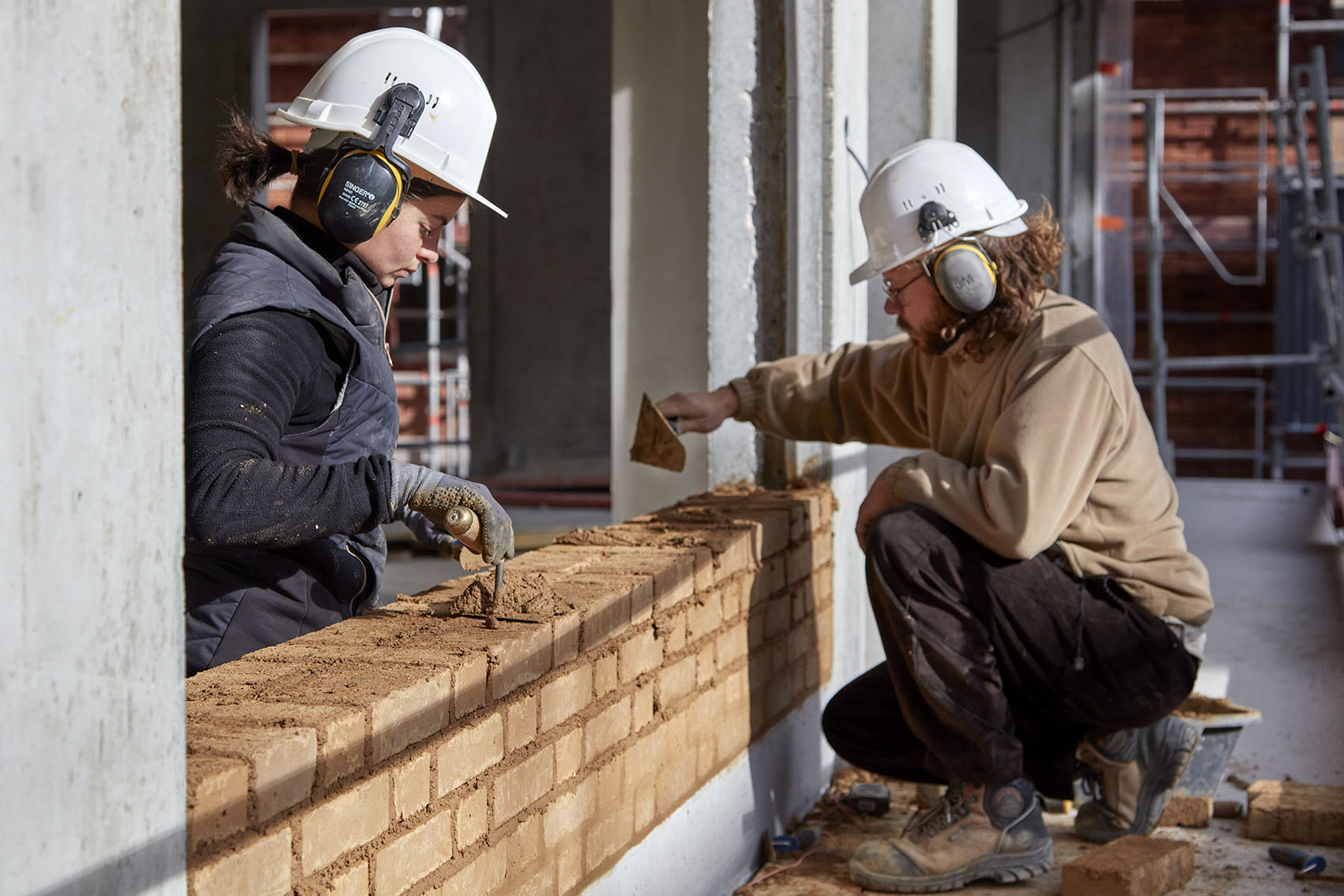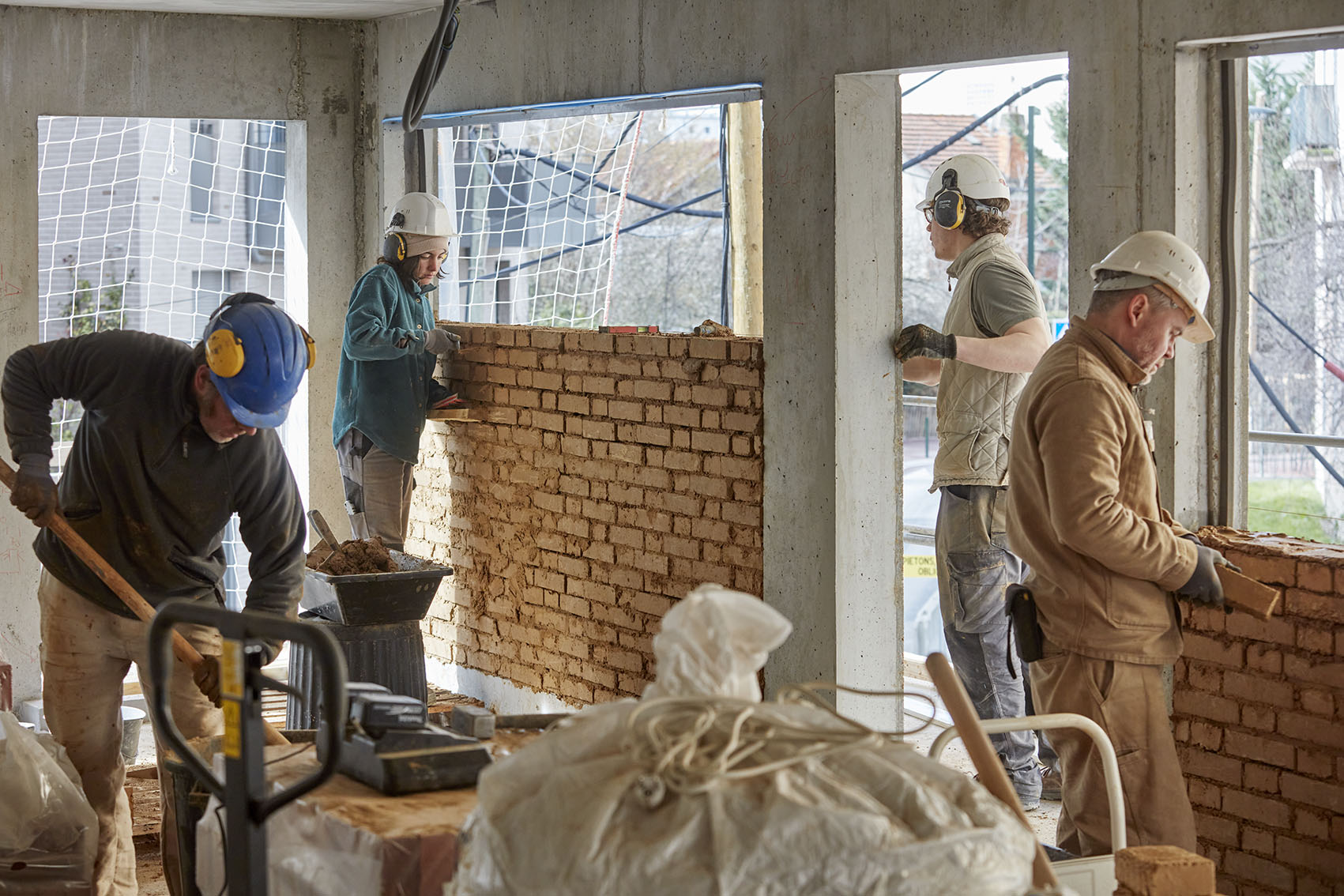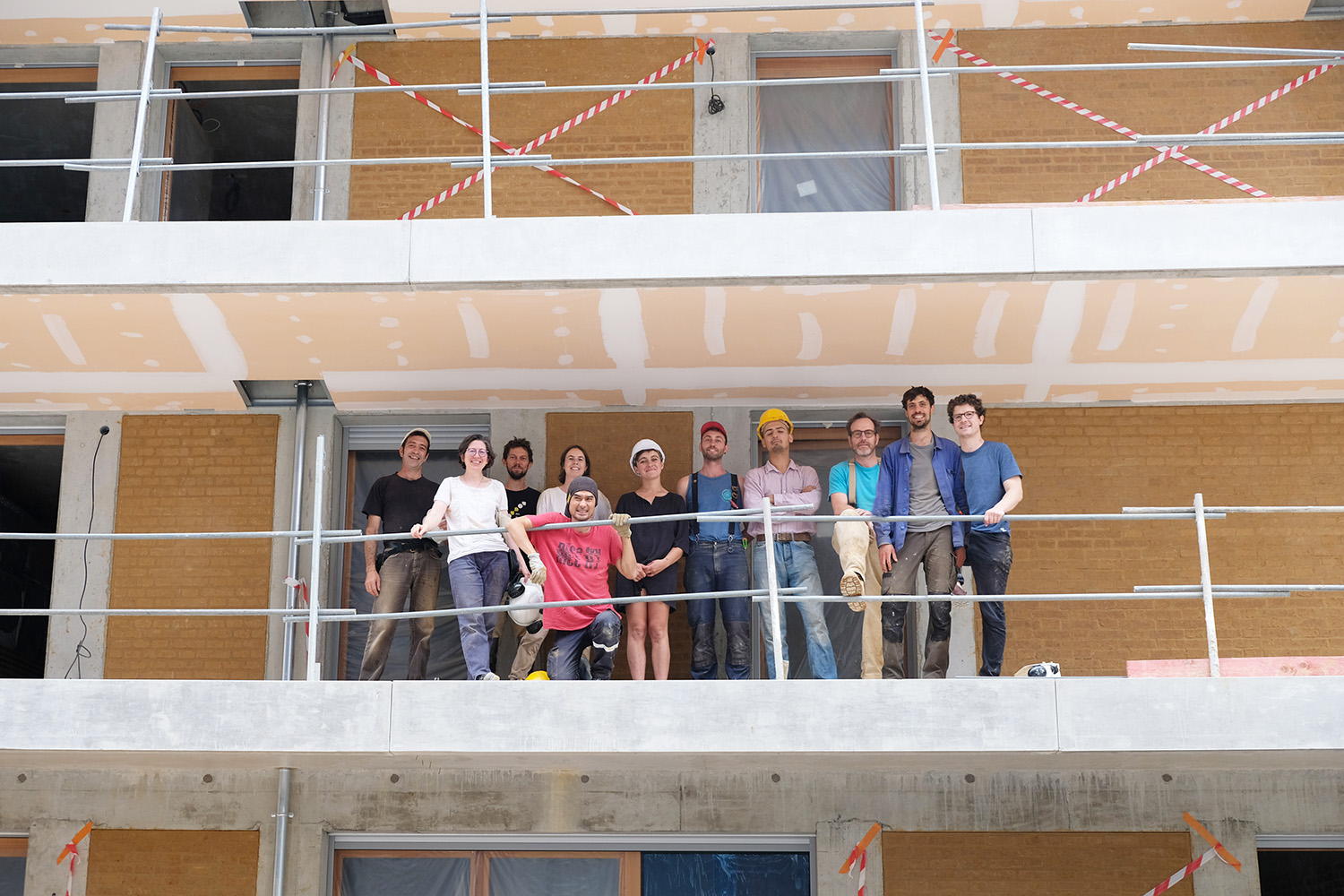Shaping a circular industrial ecosystem and supporting life-cycle thinking
Les Grands Moyens
cooperative of architects and builders committed to a radical and convivial ecological transition
A cooperative group of architects and builders committed to a radical and convivial ecological transition. We specialize in building with raw earth and straw bale, the most ecological materials ever known in Europe. We aspire to change the construction industry by developing projects that are respectful of human health environment, and empowering workers.
Our social model is based on fair remuneration, equal pay, gender equity and horizontal hierarchy (direct democracy, rotating co-management
Our social model is based on fair remuneration, equal pay, gender equity and horizontal hierarchy (direct democracy, rotating co-management
France
National
It addresses urban-rural linkages
It refers to a physical transformation of the built environment (hard investment)
Yes
2025-01-01
No
No
Yes
No
Yes
As a representative of an organisation
A cooperative group of architects and builders committed to a radical and convivial ecological transition. We specialize in building with raw earth and straw bale, the most ecological materials ever known in Europe. We aspire to change the construction industry by developing projects that are respectful of human health environment, and empowering workers.
Les Grands Moyens insulate with straw bale and build in raw-earth masonry using multiple techniques: adobes, compressed earth blocks, cob, rammed earth, plasters, etc. We also offer technical support and trainings to companies and individuals.We use the least-processed, locally-sourced, easy-to-use materials to maximize the durability and carbon footprint of our constructions. The cooperative specializes in complex, innovative new-build and renovation projects for public and private clients. Our aim is to dispel preconceived ideas and show that it is perfectly possible to build desirable, comfortable cities using these natural materials.Our social model is based on fair remuneration, equal pay, gender equity and horizontal hierarchy (direct democracy, rotating co-management, etc.).
Les Grands Moyens insulate with straw bale and build in raw-earth masonry using multiple techniques: adobes, compressed earth blocks, cob, rammed earth, plasters, etc. We also offer technical support and trainings to companies and individuals.We use the least-processed, locally-sourced, easy-to-use materials to maximize the durability and carbon footprint of our constructions. The cooperative specializes in complex, innovative new-build and renovation projects for public and private clients. Our aim is to dispel preconceived ideas and show that it is perfectly possible to build desirable, comfortable cities using these natural materials.Our social model is based on fair remuneration, equal pay, gender equity and horizontal hierarchy (direct democracy, rotating co-management, etc.).
Green transition
Earth construction
Straw construction
Horizontal hierarchy
Empowerment
Raw earth and straw bale materials, which come straight from the past, are now regaining their relevance. Unlike conventional building methods, they are far more resilient in the face of shortages, and drastically more environmentally friendly.
Throughout their entire life cycle, these natural materials consume only small amounts of energy and material resources, straw bale is even a carbon sink. They are manufactured from raw materials found close to construction sites : excavations from building sites (e.g. Greater Paris) or farm waste. They do not require large-scale mechanized tools or complex industrial processes to be produced or used. One applied their durability drastically limits the need for maintenance, with repairs limited to minor interventions. At the end of their life, these eco-materials can even be recycled : straw can be composted or used as mulch, while raw earth can be reused in other constructions (infinitely reusable) or returned to the soil.In France (and in some other European countries), we produce far more straw and excavated earth than can be used for livestock farming or as backfill. So, as well as being part of a truly circular economy, eco-construction valorizes a resource that is currently considered waste. Finally they replace highly polluting materials, and non-recyclable wastes.
In France, where thermal insulation is a real issue (heat sieve, urban heat island, etc.), straw insulation and earth masonry are proving extremely relevant, notably for the summer comfort and the thermal inertia they provide.
Throughout their entire life cycle, these natural materials consume only small amounts of energy and material resources, straw bale is even a carbon sink. They are manufactured from raw materials found close to construction sites : excavations from building sites (e.g. Greater Paris) or farm waste. They do not require large-scale mechanized tools or complex industrial processes to be produced or used. One applied their durability drastically limits the need for maintenance, with repairs limited to minor interventions. At the end of their life, these eco-materials can even be recycled : straw can be composted or used as mulch, while raw earth can be reused in other constructions (infinitely reusable) or returned to the soil.In France (and in some other European countries), we produce far more straw and excavated earth than can be used for livestock farming or as backfill. So, as well as being part of a truly circular economy, eco-construction valorizes a resource that is currently considered waste. Finally they replace highly polluting materials, and non-recyclable wastes.
In France, where thermal insulation is a real issue (heat sieve, urban heat island, etc.), straw insulation and earth masonry are proving extremely relevant, notably for the summer comfort and the thermal inertia they provide.
For the users of raw earth and straw bale of the buildings we construct, the benefits are significant compared with conventional constructions. They include
- greater thermal and hygrometric comfort
- improved acoustics
- absence of harmful volatile organic compounds in indoor air
- absorption of unpleasant odors
- easier repair of structures
For the cooperative's workers, the benefits can be summed up as follows:
- health protection (natural, non-harmful materials)
- increased skills and empowerment
- enhancement of manual labor
- greater thermal and hygrometric comfort
- improved acoustics
- absence of harmful volatile organic compounds in indoor air
- absorption of unpleasant odors
- easier repair of structures
For the cooperative's workers, the benefits can be summed up as follows:
- health protection (natural, non-harmful materials)
- increased skills and empowerment
- enhancement of manual labor
The social model of our cooperatives is based on :
- Fair remuneration : our workers earn 23% more than the conventional market;
- Equal pay : all employees and partners of the cooperative earn the same;
- Horizontal hierarchy: our governance is based on direct democracy, with members taking it in turns to be co-managers of the cooperative, and employees invited to become partners.
- Gender equity, 50% of our team are women (this year we were the largest mixed-gender professional worksite in France);
- Integration of refugees: we work with integration organizations to welcome and train refugees in our teams;
The partnership fee is low and can be paid over several years to be as inclusive as possible.
We believe in collective intelligence and collective empowerment. The variety of our backgrounds and skills has always been an asset in enriching our projects and working methods.
- Fair remuneration : our workers earn 23% more than the conventional market;
- Equal pay : all employees and partners of the cooperative earn the same;
- Horizontal hierarchy: our governance is based on direct democracy, with members taking it in turns to be co-managers of the cooperative, and employees invited to become partners.
- Gender equity, 50% of our team are women (this year we were the largest mixed-gender professional worksite in France);
- Integration of refugees: we work with integration organizations to welcome and train refugees in our teams;
The partnership fee is low and can be paid over several years to be as inclusive as possible.
We believe in collective intelligence and collective empowerment. The variety of our backgrounds and skills has always been an asset in enriching our projects and working methods.
Part of our activity is dedicated to supervising participative and/or training workcamps. In these projects, we train people from civil society to build with earth and straw. The aim is to teach them how to build or renovate their homes using these ecological techniques. By passing on this know-how, we reach a wider public, who don't necessarily have the budget to call in a professional companies. Therefore we increase on a national level the number of earth/straw bale buildings and encourage the development of the activity.
In addition, our cooperative's commitment indirectly benefits :
- to the residents’ health and comfort of our constrcutions;
- to civil society through the preservation of natural resources;
- to the cooperative's employees, whose working conditions are far better than those offered by standard building companies.
In addition, our cooperative's commitment indirectly benefits :
- to the residents’ health and comfort of our constrcutions;
- to civil society through the preservation of natural resources;
- to the cooperative's employees, whose working conditions are far better than those offered by standard building companies.
Various organizations participated directly or indirectly in the project:
- URSCOP (Union Régionale des Coopératives) supports the legal and financial set-up of the cooperative.
- The Mairie de Paris granted a subsidy to encourage the cooperative's development in the region.
- RFCP (Réseau Français de la Construction Paille) and AsTerre (Association nationale de la filière terre crue) support and give visibility to our project.
- We regularly exchange and collaborate with similar companies in Europe: BC Materials (Belgium), Fetdeterra (Spain) and Lehm Ton Erde (Austria).
- URSCOP (Union Régionale des Coopératives) supports the legal and financial set-up of the cooperative.
- The Mairie de Paris granted a subsidy to encourage the cooperative's development in the region.
- RFCP (Réseau Français de la Construction Paille) and AsTerre (Association nationale de la filière terre crue) support and give visibility to our project.
- We regularly exchange and collaborate with similar companies in Europe: BC Materials (Belgium), Fetdeterra (Spain) and Lehm Ton Erde (Austria).
Les Grands Moyens adventure began in Paris in early 2019, with a group of a dozen employed/independent architects, engineers, urban planners, project owners and craftsmen. All were united by the same observation : our activity is a non sense. Working conditions are deplorable, and the projects we carry out are damaging the planet. So we started thinking about how we could work differently, both in our social functioning (horizontal hierarchy, equal pay, etc.) and in the projects we design (transdisciplinary approach, ecological radicalism, etc.).
After two years of debate, inspiring meetings and visits to similar projects, our collective structured itself around a common ethic and organization. At the end of 2021, we launched the cooperative and participative company Les Grands Moyens in the form of two cooperatives: LGM Conception and LGM Construction.
Les Grands Moyens Conception develops ecological and participatory architecture projects.
Les Grands Moyens Construction builds with straw and raw-earth masonry using a variety of techniques: adobe, compressed earth blocks, cob, rammed earth, pasters, etc. It also offers technical support and training to companies and individuals.
The project is therefore essentially transdisciplinary. It is born of dialogue between different fields, at the crossroads of theory and practice.
After two years of debate, inspiring meetings and visits to similar projects, our collective structured itself around a common ethic and organization. At the end of 2021, we launched the cooperative and participative company Les Grands Moyens in the form of two cooperatives: LGM Conception and LGM Construction.
Les Grands Moyens Conception develops ecological and participatory architecture projects.
Les Grands Moyens Construction builds with straw and raw-earth masonry using a variety of techniques: adobe, compressed earth blocks, cob, rammed earth, pasters, etc. It also offers technical support and training to companies and individuals.
The project is therefore essentially transdisciplinary. It is born of dialogue between different fields, at the crossroads of theory and practice.
For the time being, our approach is virtually unique in France, with no other company qualified to this level of commitment.
For each new project, our cooperatives develop buildings using local/renewable materials, with environmental strategies favoring simplicity of implementation and the use of low-tech systems that facilitate repair and maintenance. Architectural design is guided by the quest for minimum embodied energy and maximum resource savings, while reenchanting occupants' uses and comfort.
Our aim is to build robust, long-lasting buildings whose components can be fully composted at the end of their life cycle (masonry, insulation, etc.), recycled for energy purposes (framework, joinery, etc.) or reused (glazing, plumbing, flooring, etc.).
Our aim is to build robust, long-lasting buildings whose components can be fully composted at the end of their life cycle (masonry, insulation, etc.), recycled for energy purposes (framework, joinery, etc.) or reused (glazing, plumbing, flooring, etc.).
The presence of numerous cereal farms and excavation sites in Europe means that straw and raw earth are available resources in many regions. These eco-materials could then be used for building.
The techniques we use are free and not protected by patents, so they are easily reproducible. In addition, we communicate openly about our social, legal and financial model to encourage other companies to set up based on our model.
Instead of competition, we prefer mutual aid and transmission. We make it a point of honor to publish books and articles, give lectures, testify in the media, supervise workcamps and teach. In our view, raising awareness and passing on information is the surest and quickest way to bring about a change of scale in the ecological transition in the coming years.
The techniques we use are free and not protected by patents, so they are easily reproducible. In addition, we communicate openly about our social, legal and financial model to encourage other companies to set up based on our model.
Instead of competition, we prefer mutual aid and transmission. We make it a point of honor to publish books and articles, give lectures, testify in the media, supervise workcamps and teach. In our view, raising awareness and passing on information is the surest and quickest way to bring about a change of scale in the ecological transition in the coming years.
The construction industry is one of the main contributors to global warming : greenhouse gas emissions, soil pollution, destruction of biodiversity... It is also responsible for the depletion of non-renewable raw materials that are so precious for the future. The production and processing of the most commonly used materials - cement, steel, glass and plastic - are problematic. They require large quantities of fossil fuels, minerals, metals and hydrocarbons. This industrial production, which is neither recyclable nor reusable, is highly polluting and devastating to the landscape. So, if we want to leave future generations the same chance of living on this planet, we urgently need to reinvent the way we build.
Sustainable construction means opting for materials that offer buildings the longest possible service life, while being compostable at the end of their life. Raw earth and straw bales are the best examples. They are renewable or infinitely reusable, non-toxic, minimally processed and available almost everywhere in the world.
The challenge for our company is to demonstrate that it is possible to rehabilitate/build a humane society while drastically limiting environmental impacts. We also want to show that our socially committed model is viable and enviable.
Sustainable construction means opting for materials that offer buildings the longest possible service life, while being compostable at the end of their life. Raw earth and straw bales are the best examples. They are renewable or infinitely reusable, non-toxic, minimally processed and available almost everywhere in the world.
The challenge for our company is to demonstrate that it is possible to rehabilitate/build a humane society while drastically limiting environmental impacts. We also want to show that our socially committed model is viable and enviable.
The project's direct and quantifiable results include the creation of 8 full-time equivalent positions in 2023 and 35 projects carried out between 2021 and 2023 in line with the ethical principles outlined above.
Here are just a few examples:
- 42 housing units in Bagneux (92220): construction of facades and partitions using raw earth bricks = 200 tonnes of earth used;
- Raising a building in Paris (75015): straw-bale insulation and raw-earth plasters;
- Restaurant in Paris (75002): floors, walls, ceilings and furniture in rammed earth and raw earth plasters;
- Construire autrement à Paris" exhibition at the Académie du Climat (75004) : prototypes showcasing bio-sourced material alternatives for insulating existing buildings;
- Vitrines Hermès in Paris (75008): creation of rammed earth furnitures;
- Maison des associations, Malakoff (92240) : straw-bale insulation and rawvearth/lime plasters;
- Supervision of integration project in Paris (75014): training in the installation of straw insulation and earth plasters;
- Insulations of individual houses in Ile-de-France, etc...
Here are just a few examples:
- 42 housing units in Bagneux (92220): construction of facades and partitions using raw earth bricks = 200 tonnes of earth used;
- Raising a building in Paris (75015): straw-bale insulation and raw-earth plasters;
- Restaurant in Paris (75002): floors, walls, ceilings and furniture in rammed earth and raw earth plasters;
- Construire autrement à Paris" exhibition at the Académie du Climat (75004) : prototypes showcasing bio-sourced material alternatives for insulating existing buildings;
- Vitrines Hermès in Paris (75008): creation of rammed earth furnitures;
- Maison des associations, Malakoff (92240) : straw-bale insulation and rawvearth/lime plasters;
- Supervision of integration project in Paris (75014): training in the installation of straw insulation and earth plasters;
- Insulations of individual houses in Ile-de-France, etc...

